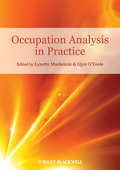
Occupation Analysis in Practice is the essential book for all future and current occupational therapists. It offers a practical approach to the analysis ofoccupations in real world practice. The book frames occupation as the key component for analysis and builds upon previous work limited to analysis at the activity level. It examines the interests, goals, abilities and contexts of individuals, groups, institutions and communities, along with the demands of theoccupation. It presents examples of occupation analysis in different practicecontext including working with children, health promotion, indigenous health,medico-legal practice; mental health and occupational rehabilitation. The book has four sections. Section 1 introduces theoretical perspectives of the concept of occupation analysis and how such analysis relates to particular models of Occupational Therapy practice and the generic World Health Organisation International Classification of Functioning, Disability and Health. Section 2 discusses analysis of particular components of occupation that support practice. These include culture, spirituality, home and community environments as well as self-care and leisure. Section 3 applies analysis of occupations to particular specialties encountered in practice. Section 4 considers the application ofOccupation Analysis within professional reasoning and goal setting. FEATURES International team of contributors Examples of occupation analysis proforma Application to a wide range of practice areas. Glossary of key terms Incudes theInternational Classification of Functioning, Disability and Health. INDICE: Notes on contributors. Preface. Part I: Theoretical Perspective onOccupation Analysis. 1 What is occupation analysis? (Gjyn OToole). 2 Models to inform occupation analysis (Gjyn OToole). 3 The relationship of the International Classification of Functioning, Disability and Health (ICF) to occupationanalysis (Lynette Mackenzie and Gjyn OToole). Part II: Analysing Relevant Components of Occupation that Underpin Practice. 4 Occupation analysis and spirituality (Lesley Wilson). 5 Cultural dimensions of occupation analysis (Ruth O. Beltran). 6 Occupation analysis and the home and community environment (Lynette Mackenzie). 7 Analysing the occupation components of self-care (Gjyn OToole). 8 Occupation analysis and leisure occupations. Part III: Application of Occupation Analysis to Specific Practice Contexts. 9 Children: Analysing the occupation of play (Anita C. Bundy). 10 Occupation analysis: cognition and acquiredbrain impairment (Chris Chapparo and Judy Ranka). 11 Dementia and occupation analysis (Gjyn OToole, Samantha Ashby and Michelle Fussell). 12 Occupation analysis and falls prevention (Lynette Mackenzie). 13 Indigenous peoples and occupation analysis (Gjyn OToole 14 Medico-legal assessments (Claudia Walker). 15 Creating occupational engagement to maximise recovery in mental health (Elizabeth Anne McKay and Katie Robinson). 16 Occupation analysis and occupational rehabilitation (Carole James). 17 Public health and health promotion (Clare Hocking). 18 Motor aspects of upper limb functioning and occupation analysis (JudyL. Ranka and Christine Chapparo). 19 Occupation analysis and successful ageing (Ann McIntyre). Part IV: The Interface Between Aspects of Practice and Occupation Analysis. 20 The importance of professional thinking and reasoning in occupation analysis. 21 Setting and evaluating person-centred goals: an outcome of occupation analysis (Steve Park). Appendix: Analysing occupations: helpful resources (Gjyn OToole and Lynette Mackenzie). Glossary. Index.
- ISBN: 978-1-4051-7738-2
- Editorial: Wiley-Blackwell
- Encuadernacion: Rústica
- Páginas: 408
- Fecha Publicación: 25/03/2011
- Nº Volúmenes: 1
- Idioma: Inglés
